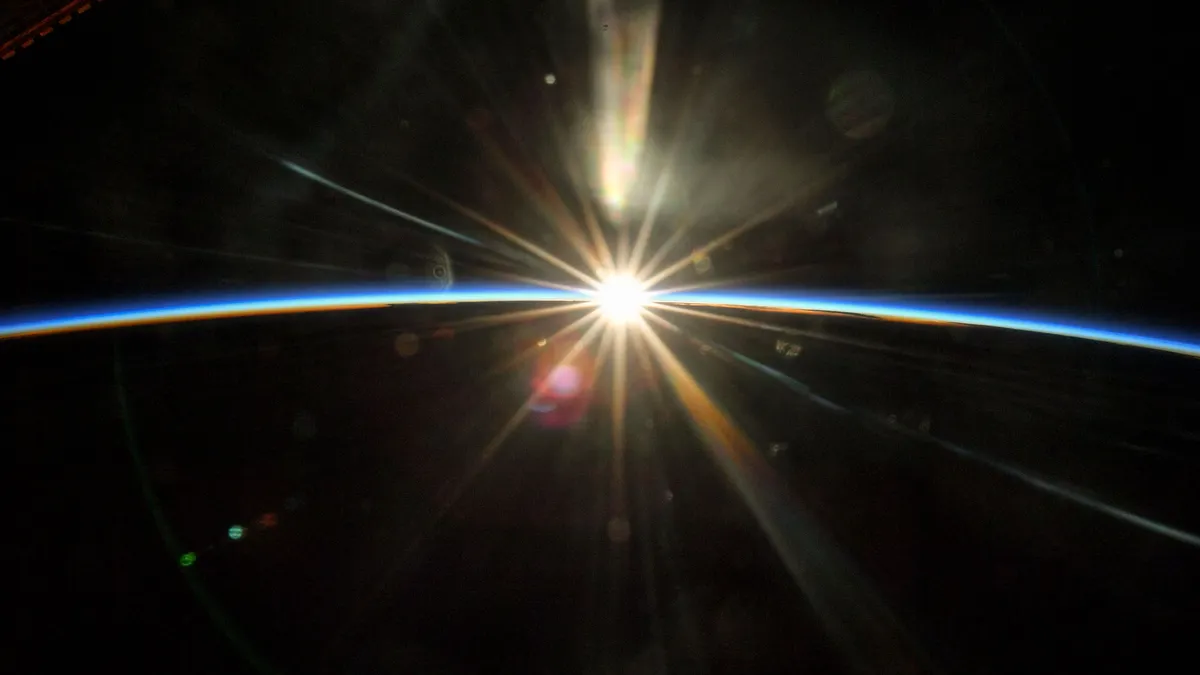"Where does space begin?" is one of those questions to which there’s no easy answer.
Well, arguably there is: from an Earth-dweller’s perspective, 'space' begins once you get outside Earth’s atmosphere.
It’s just defining where Earth’s atmosphere ends that’s the problem!

Credit: ESA/Hubble & NASA, W. Keel
That’s because Earth’s atmosphere is composed of molecules of gas, and two things molecules of gas don’t do are a) sit still and b) line up in neat, orderly rows.
So defining the outer edge of Earth’s atmosphere is pretty much impossible, because it’s a boundary that’s constantly shifting.
Consider an estuary: it’s hard to say exactly where the river (freshwater) ends and where the sea (saltwater) begins, because there’s an ever-shifting intermediary zone where the water is merely brackish.
The same kind of thing goes on with gas molecules at the outer limits of Earth’s atmosphere.

That’s the first problem, and it’s true whether you consider the atmosphere to end with the thermosphere (in which case 'space' would start about 80km up) or whether you think it also includes the exosphere – which is the second problem.
Some scientists regard this outermost region as part of interstellar space, but if you include the exosphere then space suddenly gets a lot further away, and you’d need to reach an altitude of 100,000km or so before you were in space.
As a result of these and other niggles, different scientists have proposed wildly different boundaries: some say 'space' starts once you get about 30km (19 miles) up, others have suggested you’re not truly in 'space' until Earth is a staggering 1.6 million km (990,000 miles) below you.
There’s no easy answer, but that’s not very helpful from a legal and governmental perspective.

Space and the law
If you haven’t defined where space begins, then how do you decide where one country’s airspace (and hence legal jurisdiction) ends?
What if there was a murder on the International Space Station – who’s going to prosecute that?
The nation whose astronaut was murdered, or the nation over whose territory the ISS was travelling at the time?
If you haven’t defined where space begins, how do you decide whether a flying vehicle is classed as an aircraft or a spacecraft, and so which set of regulations and guidelines it’s subject to?

And if you haven’t defined where space begins, how do you stop hustlers conning people with £20K 'space' flights that only go 10km (6mi) up? And so on.
Clearly, some kind of definition is required – even if that definition is fairly arbitrary and rule of thumb-ish.
So most international agencies and regulatory bodies define 'space' as starting at the Kármán Line.

Kármán Line explained
First proposed by Hungarian-American physicist Theodore von Kármán in the 1960s, the Kármán Line is considered the point at which space does begin, because it's the point, essentially, at which the physics of flight change.
It’s the altitude at which a craft is no longer supported primarily by the aerodynamic lift generated by its wings (like an aeroplane or helicopter), and instead maintains its altitude through a combination of inertia and centrifugal force (like an orbiting satellite).
The Kármán Line can also be looked at another way.
A small satellite trying to orbit below this point will encounter so many air molecules (which causes friction, which generates heat) that it’s likely to burn up or disintegrate before it’s completed one full orbit, whereas anything attempting to orbit above the Kármán Line should be able to do so safely.

Nothing’s ever simple when it comes to space, of course, so not all astrophysicists (or space agencies) agree about where the Kármán Line can actually be found, which means there isn't complete agreement as to where space does begin.
Some suggest the Kármán Line is at an altitude of 80km, others will argue passionately for the cut-off being at 100km.
The Fédération Aéronautique Internationale (FAI), for instance, is in the 100km camp while NASA, the NOAA and the USAF all work to the 80km rule.
Similarly, Blue Origin and Virgin Galactic both offer commercial 'spaceflights' but the latter reach altitudes in excess of 100km while Virgin Galactic flights only reach 85km.
But that’s still a lot less confusing than definitions that vary between 30 and 1.6 million kilometres!
So while it’s impossible to say exactly where “space' begins, the closest thing we have to an internationally agreed definition is the Kármán Line – which gives us a rule-of-thumb Earth/space boundary somewhere between 80 and 100km above your head right now.
Where do you think space begins? Let us know your thoughts by emailing contactus@skyatnightmagazine.com

